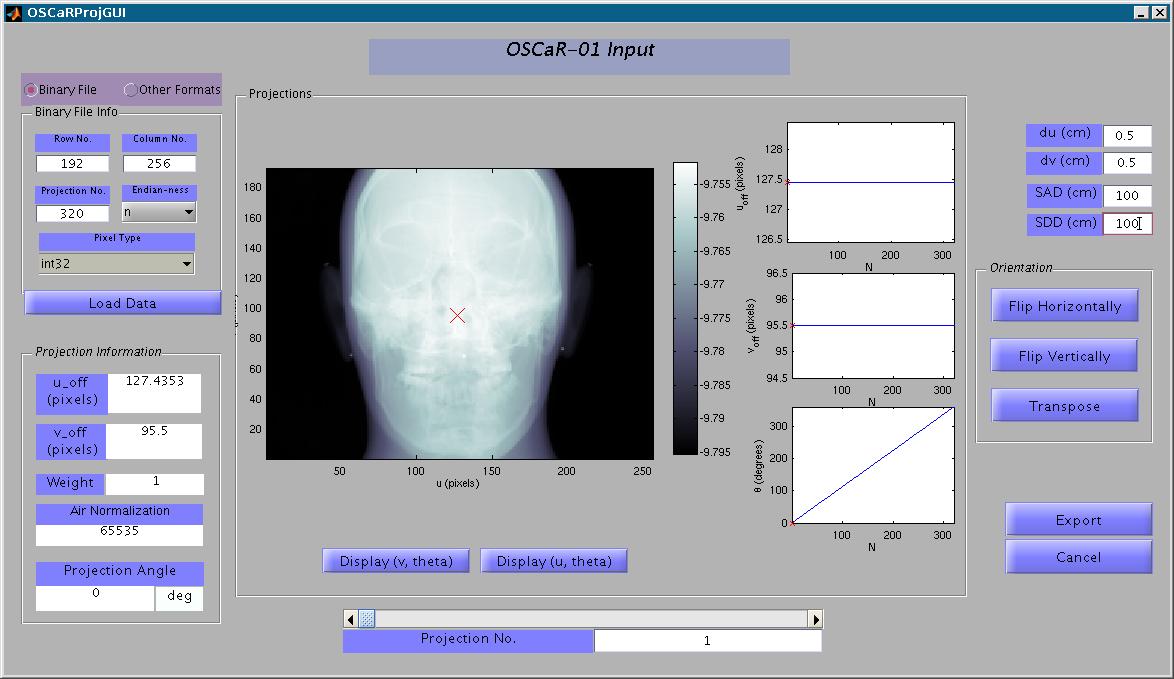The Feldkamp-Davis-Kress (FDK)
reconstruction framework for 3D cone-beam CT reconstruction has been
known since 1984. However, the lack of availability of practical, flexible, free FDK software implementations
often hampers medical physics researchers and inhibits multi-institutional research collaboration. Recognizing
the need for common, reference-able imaging research software, the American Association for Physicists in
Medicine (AAPM) Imaging Research Subcommittee has supported the development of "OSCaR", an open-source
Matlab implementation of CBCT reconstruction for free distribution as a research tool by the AAPM. The goal
is to offer a straightforward, open source code and GUI implementation that emphasizes flexibility, generality,
and ease of use. The implementation has a transparent interface for 3D image reconstruction with the intention
of providing a useful base platform for developing advanced techniques (e.g., artifact correction) or for conducting
image quality studies (e.g., selection of optimal reconstruction filters). Some simple test image data is also included.
The code is intended for research use, rather than clinical or commercial implementation.
known since 1984. However, the lack of availability of practical, flexible, free FDK software implementations
often hampers medical physics researchers and inhibits multi-institutional research collaboration. Recognizing
the need for common, reference-able imaging research software, the American Association for Physicists in
Medicine (AAPM) Imaging Research Subcommittee has supported the development of "OSCaR", an open-source
Matlab implementation of CBCT reconstruction for free distribution as a research tool by the AAPM. The goal
is to offer a straightforward, open source code and GUI implementation that emphasizes flexibility, generality,
and ease of use. The implementation has a transparent interface for 3D image reconstruction with the intention
of providing a useful base platform for developing advanced techniques (e.g., artifact correction) or for conducting
image quality studies (e.g., selection of optimal reconstruction filters). Some simple test image data is also included.
The code is intended for research use, rather than clinical or commercial implementation.
Broadly speaking, "OSCaR" consists of
three main stages: pre-processing, reconstruction, and export. In the
pre-processing stage, CBCT data is parsed from a broad, general base of standard data-file formats (e.g., DICOM,
binary, JPEG, TIFF, PNG, etc.). Geometric corrections, pixel aperture, sampling, air normalization, and other
device-dependent parameters associated with the projection data are applied. In the reconstruction stage, "OSCaR"
permits the specification of a Field-Of-View (FOV), voxel size, and reconstruction filters. The actual voxel-driven
reconstruction uses the well-known FDK filtered back-projection algorithm. In the export stage the reconstructed
data and the maximum/minimum of the reconstructed volume can be saved in a *.mat file.
Although compiled software is certainly faster than interpreted Matlab code, a Matlab implementation circumvents
the use of custom compilation libraries. The result is a software tool that is easy to use and can be rapidly adapted
and modified for new research purposes. In accordance with the desires of the AAPM Imaging Research
Subcommittee, "OSCaR" will be made freely available on the AAPM web-site to members of the AAPM for research
in algorithm development, CBCT image quality, and multi-institutional collaboration.
pre-processing stage, CBCT data is parsed from a broad, general base of standard data-file formats (e.g., DICOM,
binary, JPEG, TIFF, PNG, etc.). Geometric corrections, pixel aperture, sampling, air normalization, and other
device-dependent parameters associated with the projection data are applied. In the reconstruction stage, "OSCaR"
permits the specification of a Field-Of-View (FOV), voxel size, and reconstruction filters. The actual voxel-driven
reconstruction uses the well-known FDK filtered back-projection algorithm. In the export stage the reconstructed
data and the maximum/minimum of the reconstructed volume can be saved in a *.mat file.
Although compiled software is certainly faster than interpreted Matlab code, a Matlab implementation circumvents
the use of custom compilation libraries. The result is a software tool that is easy to use and can be rapidly adapted
and modified for new research purposes. In accordance with the desires of the AAPM Imaging Research
Subcommittee, "OSCaR" will be made freely available on the AAPM web-site to members of the AAPM for research
in algorithm development, CBCT image quality, and multi-institutional collaboration.
Right now "OSCaR" is in the beta-testing stage. You can download "OSCaR-01" here. Any feedback on this version of
our software would be greatly appreciated.
GUI of the Pre-Processing Stage:

GUI of the Processing Stage:

- This work was supported by the AAPM Imaging Research Subcommittee, MITACS and Princess Margaret Hospital.
Back to my home page